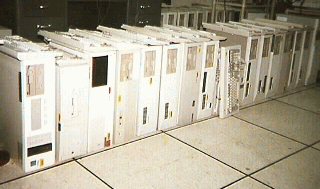
Two environmental researchers, Forrest Hoffman and Bill Hargrove, of the Oak Ridge National Laboratory in Tennessee, United States of America, made use of cheap and thrown away 486 micro-computers to build a supercomputer.
Making use of parallel computing, a massive number crunching exercise could be divided into smaller components to be processed by individual micro-computers. The results produced by the micro-computers would then be integrated and analyzed by a single central processor in one micro-computer.
Theoretically, this supercomputer, known as Stone Souper computer. can process 1.5 million floating point operations per second, or 1.5 MFLOPS. This speed is equivalent to one seventh of a powerful parallel computer. At the moment, researchers are using the Stone Souper computer to run a parallel algorithm useful in analyzing envrionmental information including a variety of soil characteristics data.
The Stone Souper computer is not only cheap, it can be continually updated and upgraded. For instance, the number of micro-computer connected can be increased and that the 486 micro-computers could eventually be replaced by the more powerful Pentium micro-computers. Up to 22 January, the number of micro-computers connected to form the Stone Souper computer has increased to 64.